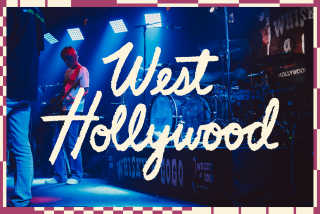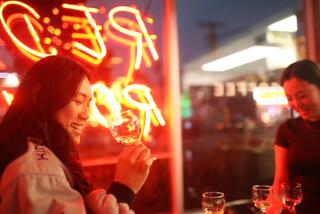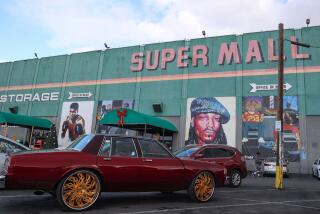Riots claimed 200 liquor stores, but South L.A. still suffers
There used to be a liquor store next to Frances Fikes’ church on Normandie Avenue in South Los Angeles.
But the store burned down 20 years ago, on the first night of the riots.
“I didn’t do it,” she said bluntly, without a hint of joking in her voice. “But I’m happy it’s gone. I was asleep. It was 3 a.m. when it burned. “
I get the feeling that Mrs. Fikes could have done it, if she weren’t such a good Christian woman.
“It was a terrible place. Ter-ri-ble!” she said, indignant at the memory.
The men who hung around the store would urinate on the sidewalk and barge into the sanctuary during worship.
“They’d ask for money. We would offer them food, but that wasn’t what they wanted.”
One morning after Sunday school, with children crowding the candy aisle, the store owner leaped over the counter with a gun and fired at a shoplifter.
“It was frightening,” Mrs. Fikes said. “We suffered. We didn’t know what to do.”
The riots took care of it for them.
The owner cleared the rubble, fenced off the spot and let the church use it as a parking lot. When he applied to rebuild, vanloads of churchgoers protested and the city denied his permit.
Today, that corner is home to a tidy apartment building, ringed by well-tended rosebushes and a sturdy wrought-iron fence.
It’s an awkward thing to celebrate. But the riots accomplished in three days what years of protests could not: 200 liquor stores were wiped out, in a 51-square-mile swath of the city weighted down with more than 600.
The payoff was big: less crime, cleaner streets and fewer ugly scenes.
But controlling their numbers going forward will take more than a match and kerosene.
::
There are nearly 70,000 more people today in South Los Angeles than there were 20 years ago, census figures show. And liquor license records show 174 fewer liquor stores.
That’s a tribute to the persistence and resilience of a long-suffering community.
Some stores call themselves mini-markets now. Picture windows have replaced cinder-block walls. The owners know better than to toss a customer’s change across the counter. They count it out politely instead, from behind bulletproof barriers.
They’re not the shops that the suburbs know as a pit stop on the way home from work.
They sell six-packs of beer, one can at a time, and charge 50 cents for a “loosie,” a single cigarette.
At their worst, they’re a reflection of what’s wrong in South Los Angeles: high prices, poor service; a magnet for addicts and dealers.
At their most benign, they’re impromptu gathering spots in neighborhoods long on economic woe and short on markets and parks — in communities where the only open space might be a fenced-off, riot-ravaged lot.
The liquor stores were flashpoints for trouble long before Rodney King, and before teenager Latasha Harlins was shot to death by a Korean store owner two weeks after King’s beating. Soon Ja Du was convicted by a jury of manslaughter, but kept out of jail by a sympathetic judge.
The riots were considered, in some neighborhoods, a chance to settle the score. Some black-owned stores were left untouched, while those run by Koreans were torched.
Before the riots, 45% of the liquor stores in South L.A. were operated by Koreans, according to a Times analysis of owners’ names. Now only about one-third (158) are Korean.
But the proliferation of liquor stores — not the ethnicity of owners — is what drags the community down.
“Drugs, prostitution, violence — the liquor store was the place where all that converged,” said Joanne Kim, a leader of the South Los Angeles Community Coalition, which is heading the fight to close them.
Even now, the stores seem to be on every corner, thriving at the intersection of need and disorder.
A mother pushing a baby stroller, shopping for milk, would line up at the liquor store counter alongside an addict buying a glass pipe for the rock of crack that he purchased from a dealer in the parking lot.
Outside, customers would drink and use drugs openly. Some sidewalks had folding chairs, even couches. There were fights and robberies. Prostitutes competed for customers.
For neighbors, the scene was embarrassing.
Marqueece Harris-Dawson, the Community Coalition’s chief executive, grew up near 110th Street and Normandie Avenue, with a liquor store on his street corner. As a kid, he couldn’t shop there after 3 p.m. “because by then everybody who’d been there drinking would be inebriated,” he recalled.
“If we were going to have guests and they were going to arrive after that time, my parents would give directions that would take them down another street … rather than let them see that corner.”
::
Until the riots, Warren Jones was one of those inebriated liquor store louts. He lived next door to Mrs. Fikes’ church and passed his days at the corner store.
He watched it burn that night. A liquor store at the other end of the block burned too; it’s been replaced by a doughnut shop.
“When they first burned down, I didn’t think it was too cool,” he said. “I didn’t have no place to buy my alcohol.”
He was an alcoholic back then, he told me as we walked the block. I didn’t ask his status now; I could smell the alcohol.
At 60, he wants his neighborhood quiet. He’s lived there all his life. He can remember when the church didn’t need window bars.
“Things got bad for a while,” he said. “Getting rid of the liquor stores didn’t solve the problem, but over time, it was a very good thing.”
::
It’s the “over time” part that’s frustrating.
The move to clamp down on liquor stores began years before the riots, when the city made it tougher to open new stores by requiring zoning permits that could be loaded with restrictive conditions.
That’s the tool the Community Coalition used to keep all but 50 of the burned-out stores from reopening.
Some are still empty buildings or vacant lots. Many were replaced by child-care centers, fast-food outlets or laundromats. The coalition is trying to persuade others to alter their stores, to sell more fresh food and less alcohol.
But the movement stalls when liquor store owners resist. And residents are mindful that there are bigger problems, like unemployment and foreclosures.
“They’re not asking for anything different than people in Santa Monica and Larchmont are,” the coalition’s Kim said. “But there’s an attitude of ‘You people should be happy with any kind of business you get. You should tolerate anything.’ ”
The former Lucky Liquor is exhibit A.
The store at 61st Street and Vermont Avenue was declared a “public nuisance” and allowed to rebuild after the riots by complying with 19 operating conditions that covered everything from the conduct of customers to the condition of the alley behind the store.
Years passed, and little enforcement occurred, even after a new operator took over and changed the name to Vermont Liquor.
Public zoning records sketch an ugly scene: Trash bins overflowed. Men drank boldly in the parking lot and lounged on bar stools they set up on the sidewalk. One zoning inspector was too scared to even check out the corner, “unsafe with gang activity.”
At a hearing in 2007, police outlined dozens of arrests — including the store’s security guard for being a felon in possession of a gun.
Still, some locals defended the store as a harmless neighborhood hangout — “like going to the park,” said Shanea Lyons.
Two years later, the city revoked its permit to operate. But it would take until January of this year for Vermont Liquor to shut down.
The store reopened two weeks ago. It’s clean and bright, stocked with food and cleaning products.
The Korean couple that own it have applied for a liquor license. Beer and wine bring customers in “to buy the other products,” their son Max Kim said.
There’s a giant sign in the window now. “NO Loitering, Littering or Drinking.”
I didn’t see any customers.
I did sense an uneasy peace — one that reflects evolving change and enduring consensual need.
One in a series of stories about the 1992 riots and how they reshaped Southern California.
More to Read
Sign up for Essential California
The most important California stories and recommendations in your inbox every morning.
You may occasionally receive promotional content from the Los Angeles Times.










